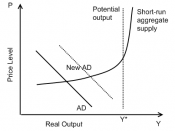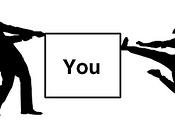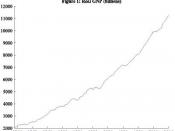Economic activity refers to the production of g&S by individuals, firms, and governments, that is, it is the process of converting scarce resources into G&S that satisfies society's needs and wants.
The level of economic activity is a macroeconomic term which refers to the general pace at which an economy is producing goods and services.
The Business Cycle is the name given to the periodic fluctuations in the level of economic activity that arise from movements in the level of aggregate demand. Thus, it helps describes how the level of economic activity changes over the years.
â¢Contraction: A period of decline in which economic activity decreases for at least six months is termed a contraction. Normally follows a pear/boom. If severe, production may even fall. Usually after time lag, unemployment rates starts to rise and often inflation eases.
â¢Trough (sometimes recessions): The end of a contraction and transition to an expansion is designated a trough.
Represents the lowest point on the business cycle of Economic Activity. At times this trough is simply a minor slowdown in economic growth causing slight raise in unemployment, but if sever for example a drop in the level of national output during a six month period, this is called a recession. Longer and even more severe troughs are called depressions where inflation may even be negative.
â¢Expansion: A period of growth in which economic activity or production tends to increase from month to month and year to year is termed an expansion. Expansions usually last about three to four years, but some have gone on as a long as a decade. After a lag time, employment grows, unemployment falls and inflation gradually starts to accelerate. The early part of an expansion is often termed a recovery.
â¢Peak: A period of expansion eventually reaches a peak.


